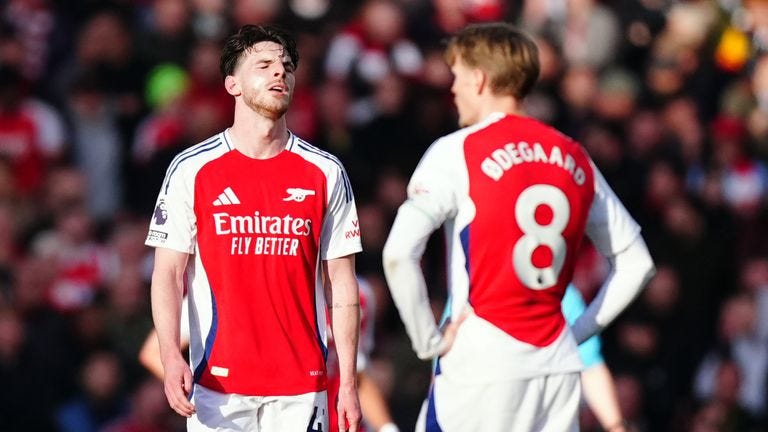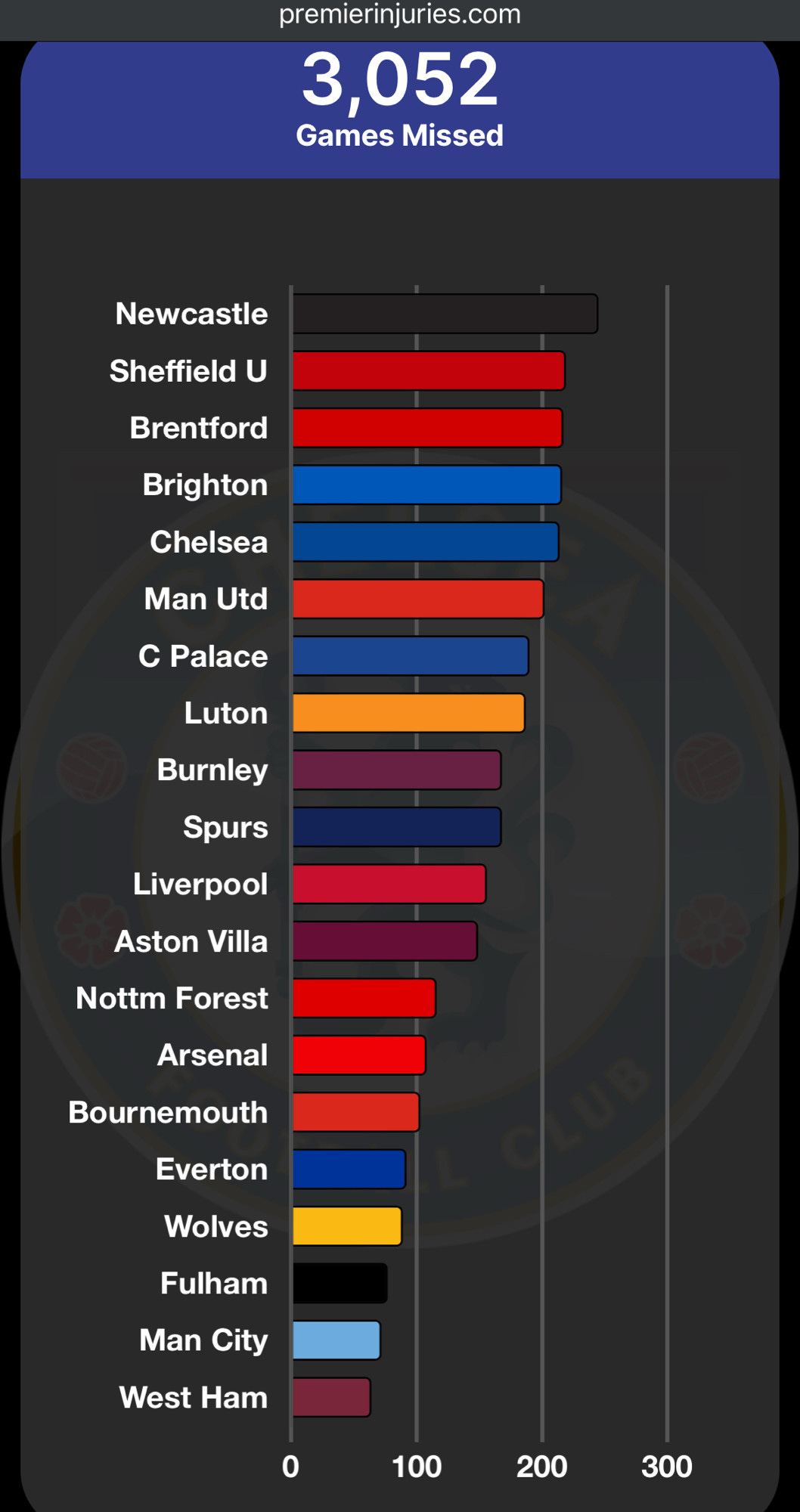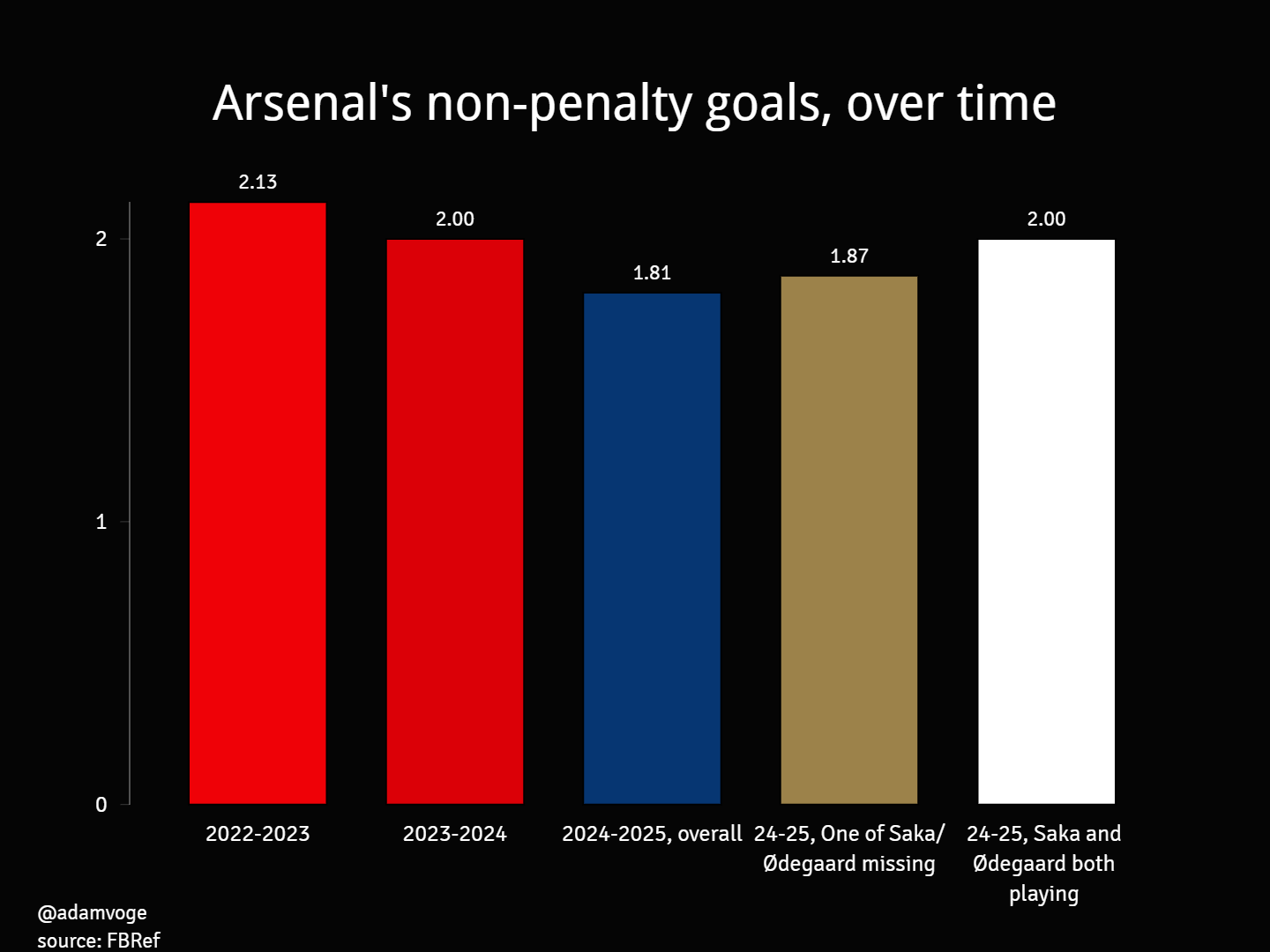Reminder: Arsenal's attack is quite good when everyone's not injured
A trip through some brighter times, and what that means for the future
Somewhere between Arsenal’s season being so over when Bukayo Saka tore his hamstring, and then being so back when Liverpool dropped some points, and so over again when Arsenal didn’t sign anybody and Kai Havertz and Gabriel Martinelli got hurt, but then so back again when Liverpool dropped some more points and Merino nabbed a brace at Leicester, and then finally so over once again when an Arsenal without Saka, Martinelli or Havertz somehow lacked attacking sharpness against West Ham at lost 1-0, people somehow forgot a basic truth about Arsenal Football Club: This club’s attack is not what we saw on the pitch this past weekend.
There were whispers from folks I know well, and whose poor choices led them to Twitter right after the match, of posts getting attention calling for Arsenal to rebuild. And while I won’t put myself through the rigor of going to find those posts, I will for the purposes of this piece treat that as a somewhat serious idea.
I personally did run across some ideas later in the weekend (during the Newcastle game) an idea shared that Arsenal, even at full strength, never had the potent attack that could keep them in matches. It’s worth noting that this was as Newcastle was pasting Forest in a match that would end 4-3.
There are, of course, so many things going on here. Chief among them, it’s a hard time to be an Arsenal fan. So many different obstacles have heaved themselves into the path before the club that, even on their own, would make it difficult to win a league title, or a Champions League. For instance, it would be difficult to win either without Martin Ødegaard for any length of time. It would be difficult to win either without Bukayo Saka. It would be difficult to win either without Kai Havertz. Repeat the same sentence for Ben White, Gabriel Martinelli, and on we go.
Of course, every single one of these things have happened this season, many of them simultaneously. And we still found ourselves asking, in mid-February, if a side without Saka and Martinelli for up to another month, and without Jesus and Havertz for the rest of the season, could still win the title. That’s pretty remarkable.
I did personally share the preference of many that Arsenal make a gap signing in January. But I also understood Arteta’s logic for not doing so, covered at the link there. And I also don’t believe the names for hire could’ve saved us, for instance, from Declan Rice and Gabriel and Riccardo Calafiori collectively dropping performances that cost this fledgling Arsenal side a chance at a result.
But you’d expect all of this to sort of exacerbate “the excuse” here, wouldn’t you? Manchester City at one point this season won once in 12 games. The causes are fairly obvious - they’ve been dealing with injuries, particularly some big ones like Rodri’s ACL. And yet I’ve seen numerous people ask if they could edge their way back into the title race, or worry about being matched up against them in the Champions League. Why? Because they’re still Manchester freakin’ City. Maybe some of their fall from grace is due to aging, but that’s got nothing to do with Arsenal.
Every. Single. Discussion. of what happened to Liverpool last season inevitably ends up in the same place…”they had a ton of injuries!!!” All the Twitter bros who think Arsenal just had its worst summer since Cech only might die of cringe at what the Merseyside reds did this past summer, signing only Federico Chiesa (who has now played 9.9% of available minutes this season) and a €30m keeper who was loaned back to the selling club. And yet, here they are in first place, with four reliable attackers (using the Gabriel Jesus scale, Chiesa and Jota cannot be counted as reliable attackers), and about to run off with a league title.
Honestly, I have no idea why so many Arsenal fans are so quick to recite Liverpool’s injury history from last season (which is not even that bad, see below) but hold Arsenal to the standard of “should still be near first after three months without Saka.” But after seeing comments about Arsenal’s attack not being good even when they were fully fit, I decided this was a piece that probably needed to happen.
So, let’s hop into our time machine back to the past two seasons, before we knew players other than Partey, Jesus and Tomiyasu could even suffer an injury. Arsenal’s attack ranked 2nd in the Premier League with 1.81 non-penalty xG per 90 minutes during the surprise 22-23 title chase, which made them the sixth-attackingest unit among Europe’s 98 clubs in the “Big Five” leagues.
The next season, a significantly more boring Arsenal plummeted to 1.80 npxG per 90, falling all the way to fourth in the league and 9th in Europe.
This season, we’ve seen a much more notable drop to 1.53 npxG, which represents a 15% loss in production. The disturbing thing is that if I left the first three bars here, some fans of the club might simply say, “see, the attack is a lot worse this season, we need to make big changes” and move on.
But, notably, less than 40% of league games this season have featured Arsenal’s top two creators playing together, which is your far-right bar in the chart. Those 11 games with both Ødegaard and Saka include 9 of Arsenal’s 13 top npxG outputs this season, and 5 of the top 7 (Southampton and Leicester home are two matches where the club missed Ødegaard but still produced massively, and they’re messing up numbers quite a bit for these samples).
What’s crazy is that these games with Ødegaard and Saka also could have been even more productive. To wit:
Included in this sample is Brighton home, where Arsenal produced 1.1 xG in the first 49 minutes and were comfortably in control before Declan Rice was sent off, and only got the rest in a quick three-minute sequence trying to get back ahead late.
It also includes the 5-2 win at West Ham, where Arsenal scored five in the first half and then notably took its foot off the gas during the second frame. With two of the goals having been penalties, this match actually had a negative influence on a number of stats that you’ll see below!
Arsenal scored an outstanding 81 goals not counting penalties as they surprised everyone and pushed City to the brink in 22-23, their per90 rate matching PSG for fourth in Europe. They scored more goals the next campaign but more were penalties, dropping their non-penalty rate to 2 per 90, second in the league again and ninth in Europe.
You may be surprised to learn that, despite the drop to 1.81 npGoals per 90 minutes, Arsenal are still in fourth in the Premier League this season. Unsurprisingly, the presence of Saka and Ødegaard this season has enabled Arsenal to score at its most productive clip, matching last season’s 2 per 90 minutes. Whether this is “it factor” stuff, vibes, confidence, pitch spacing or all of the above, is open to interpretation.
On the “one missing” bar, which actually outpaces the overall rate of 1.81 per 90, here’s the situation:
In the 15 matches where Arsenal have missed one of Ødegaard or Saka, they’ve had the Southampton and Leicester matches, which we’ve already talked about but were at least pretty consistent between expected goals and actual goals, but then there’s 5-1 over City, where Arsenal were…pretty fortunate. Those three matches are worth 12 of the 28 goals (43%) in these games but only about 8.2 of the 22.5 xG (36.4%).
Chance creation is another topic that’s been pretty hot over the past couple of weeks. I wrote on it a bit last week, and Scott’s followed up with some posts about Ødegaard’s creation this season, as have I (consult your social medium of choice).
In 22-23, Arsenal averaged 1.41 expected goals assisted (xAG) per 90 minutes, third in the league after only City and Liverpool and good for eighth in Europe. The next season, Arsenal averaged 1.46 xAG per 90, a rise of about 3.5% and good for fourth in the PL and ninth in Europe.
This season, we’ve seen that number drop to 1.21 per 90, which is down 17.1%, again in that 15-20% range of where most of Arsenal’s attack has dropped off. As things stand, Arsenal are seventh in the Premier League for xAG, and 22nd in Europe.
But look at the bar chart below, and you’ll see something very, very interesting: At “full strength,” Arsenal’s xAG has actually been even better this season than the previous two. At 1.49, Arsenal would be back among the league and Europe’s best.
Is this a matter of skew? Absolutely not. In the 10-match data set, the lowest value is 0.9 against Aston Villa, and the highest is 2.0 against Crystal Palace. Those two also happen to be the only two that are more than a standard deviation away from the mean. The median value also happens to be 1.5; all of this indicates a very tight and consistent data set.
Naturally, having your best creators allows you to spend more time in the opponent’s box. Arsenal were just coming into their own in that first 22-23 campaign and averaged 34.1 touches per 90 in that area. On a per-90 basis, only Bayern Munich spent more time in their opponent’s penalty area that season than Arsenal.
Last season, Arsenal’s touches in the opposition box skyrocketed to 38.9, the most in Europe. But this season it’s back down to 33.5 per 90, again a very high-ranking number overall despite the drop, behind only City and Liverpool in England and Bayern and PSG from the continent. Though there isn’t a great deal of difference with or without the big names here, Arsenal have done a bit better with their best players in the lineup.
This of course means Arsenal have also long been a leader in carries into the penalty area, another metric that can show territorial domination.
In 22-23, Arsenal averaged 7.39 carries into the box per 90, third in Europe behind only Bayern and Real Madrid. The next season, that number leapt to 8.61, which only City and Tottenham could beat.
This season, we’ve regressed back to 7.38, which is way down from one year ago but oddly right back at the level of “fun Arsenal” two years ago. That is currently fourth in this very carry-happy Premier League and eighth in Europe.
What’s going on here with the white and gold bars? I honestly don’t know. It’s possible that it’s opponent driven, with matches like Everton and Forest featuring Arsenal camped in the opponent’s boxes with their most touches there all season but fewest carries. It could also happen that those games coincide with Arsenal taking a different route into the penalty area (passing), which happens to be true in the case of Forest and Fulham, the club’s third- and sixth-highest outputs for passes into the box this season. Regardless of the cause, you wouldn’t consider getting the ball into the box this frequently a cause for concern, unless your focus as a club was attack and only attack.
Speaking of, that’s probably as good a place as any to remind that for all the talk about Arsenal’s stale, boring, flaccid, blunt attack, football is not won and lost in the attacking third alone. After all, it’s called the attacking third.
The club that generates the fourth-most xG in the Premier League is currently sat 12th on the table. In Germany, the fifth-best attacking side are currently 10th on the table. Of course, the point I’m making is that football is played in attack, midfield and defense. For all their challenges this season, Arsenal remain 10th in Europe in xG difference per 90, and eighth in real (non-nerdy) goal difference. They’re second in the PL in both of those measures.
Things may get a little worse from here before they get better, but whether they do or don’t, I think I put it about as well as I’m able in this post:
This season, Liverpool returned with the same XI they tried to go with last season and won (jinx?!!?!?) the damn thing. I’m still expecting some moves to happen this summer, but from where I sit, I refuse to accept that Raya-White-Saliba-Gabriel-Calafiori-???-Rice-Ødegaard-Martinelli-Havertz-Saka wouldn’t be amongst the favorites in next season’s Premier League and Champions League again, particularly considering I didn’t name Timber, Merino, Nwaneri, Lewis-Skelly or any actual new signing there.
I’m not going to be able to stop anyone from getting down on what Arsenal actually do on the pitch, even if they spent the 48 hours before the match downplaying the importance of the match. That’s just life. But we can remain thankful that the folks in charge remain patient and holistic in their approach.
There’s always…gulp…next season.










Gosh it's nice to read something that makes sense.
"But, notably, less than 40% of league games this season have featured Arsenal’s top two creators playing together..."
This has been a really frustrating season. Really frustrating.